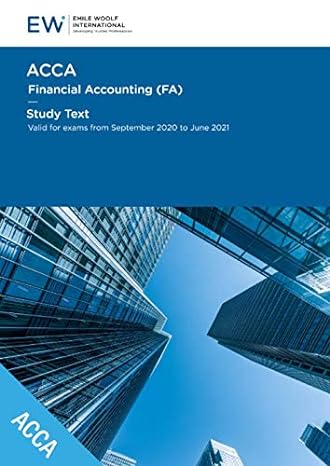Question
KDHK Corporation ( A C Corporation) KDHK is a private, not for profit, corporation that owns an airplane. The plane is a Cessna 182 high
KDHK Corporation ( A C Corporation)
KDHK is a private, not for profit, corporation that owns an airplane.
The plane
is a Cessna 182 high performance four seat aircraft. The plane is 28 years old but in spite of its age is in very good condition. It is equipped with less than state of the art avionics, but all of the systems are in excellent shape and meet all regulations of the FAA. The engine has less than 100 hours of flying time after being replaced several months ago but the propeller is approaching replacement time and will be replaced in approximately 40 flying hours. The outside paint is new and in excellent condition. The interior is in good condition, but aging and should probably be replaced in the next 3 years.
The owners
There are four private pilots with many hours of flying time. These pilots are between the ages of 50 and 65 and all have been owners for at least 10 years. Each owner holds 1 share of the company stock (25%) and there are no other shares outstanding. The corporation is a not for profit company and pays no taxes. As a corporation its liability is limited to the worth of the company which consists or the value of the plane and a small bank account that contains cash reserves for major maintenance and unusual events. The account is now worth $2,568.00
Airplane costs and facts
The recently appraised value of the plane is approximately $175,000.00. The expected life in its present condition is 4000 flying hours. The four pilots combined usage of the aircraft is 200 hrs. per year.
The propeller is valued at $6,000.00 and has approximately 40 hours of useful life at this point. A new propeller will cost $17,000.
Annual maintenance costs are approximately $1,700 which includes an annual inspection, parts changes, labor and documentation.
Fuel cost $6.15 per gal and the plane consumes 13 gals per hour.
Oil is $5.40 a quart and is consumed at .25 quarts per flying hour.
Other annual fixed costs:
Altimeter check $650.00
Annual State cert. $500.00
Insurance $1800.00
Hanger fees $5,000.00
Filters, hoses, misc. $800.00
Other costs include Tires $250.00 each (2) Each tire can be used for 400 hours. The tires are new. Battery cost $350.00 and will last 300 hours, it is also new.
The Project
The owners now pay a monthly fixed payment to the corporation plus the cost of all variable costs (gas and oil and other variable costs) Fuel is replaced and paid for by the using pilots before returning the plane to the hanger after each trip. The owners also maintain all of their own licensing fees, training certifications, medical exams and their own biannual testing by the FAA and any other costs that are of a personal nature. The fee structure is supposed to pay for all of the costs of operating the airplane and the cost of any unexpected or catastrophic expenses such as unexpected engine damage, prop damage or major instrument failure. Any shortages, not covered in the regular fees paid, are assessed equally to the owners by the corporation each year end.
The owners are considering renting the airplane to other pilots on a fee per hour basis in order to defray operating cost of the plane. The added costs to the corporation if the plane is rented include; added liability insurance of $5,000 annually, added maintenance inspections of $1,500 annually, administration cost of $4,000 annually. Each pilot applying to fly the plane would be responsible for their own costs of background checks, certification and personal insurance.
- If the owners do not rent the aircraft, how you would structure the monthly fees paid by the owners to support the aircraft.
- If owners do rent the plane to other pilots, how would you structure the fees paid by the owners and the hourly rental fees paid by the renting pilots?
An aircraft of this type and configuration rents in the Chicago area for approximately $275.00 per hour.
Your can make any assumptions you feel make sense under both proposals. An example would be; maintaining a cash reserve to cover unusual issues to prevent sudden need for cash when maintenance or other cost issues come up i.e. fees and charges from state and local authorities or taxing bodies, airport fees or rental fee increases, or reserves for future capital to be used for upgrades.
Be brief, but use the numbers in the above scenario, or ones you feel appropriate to construct the fee structures. Consider fixed and variable costs in your analysis. The use of excel sheets to show your work should be attached.
Step by Step Solution
There are 3 Steps involved in it
Step: 1

Get Instant Access to Expert-Tailored Solutions
See step-by-step solutions with expert insights and AI powered tools for academic success
Step: 2

Step: 3

Ace Your Homework with AI
Get the answers you need in no time with our AI-driven, step-by-step assistance
Get Started


